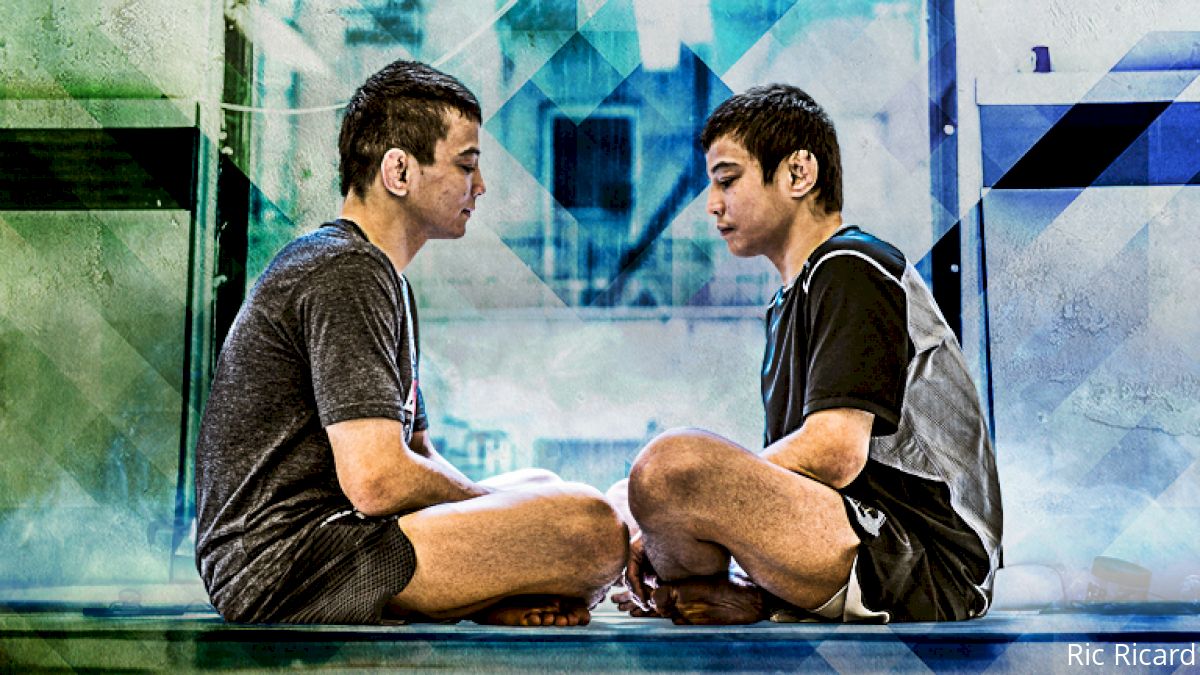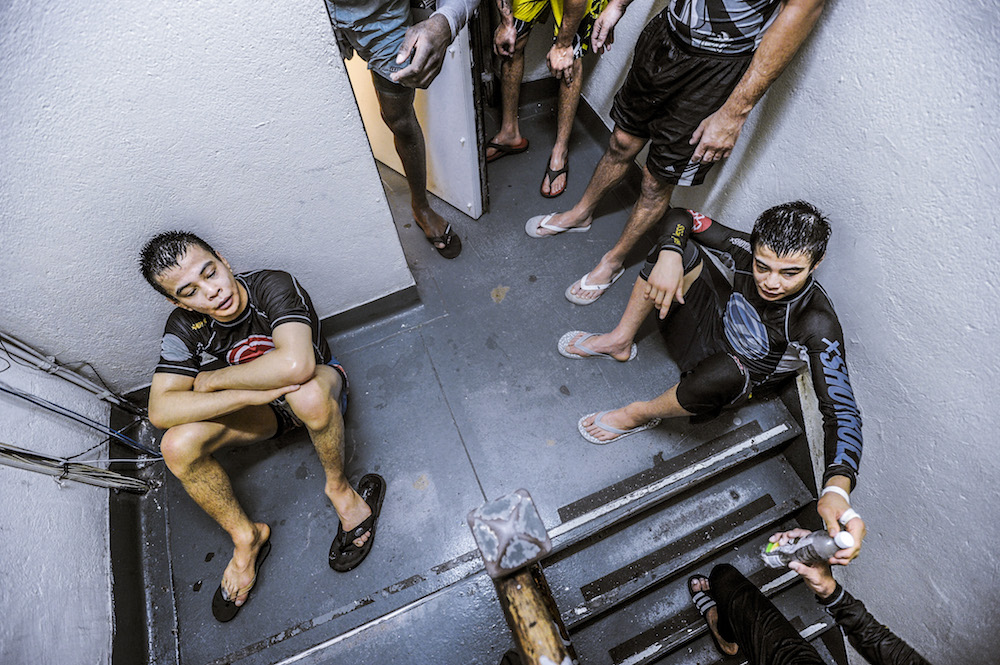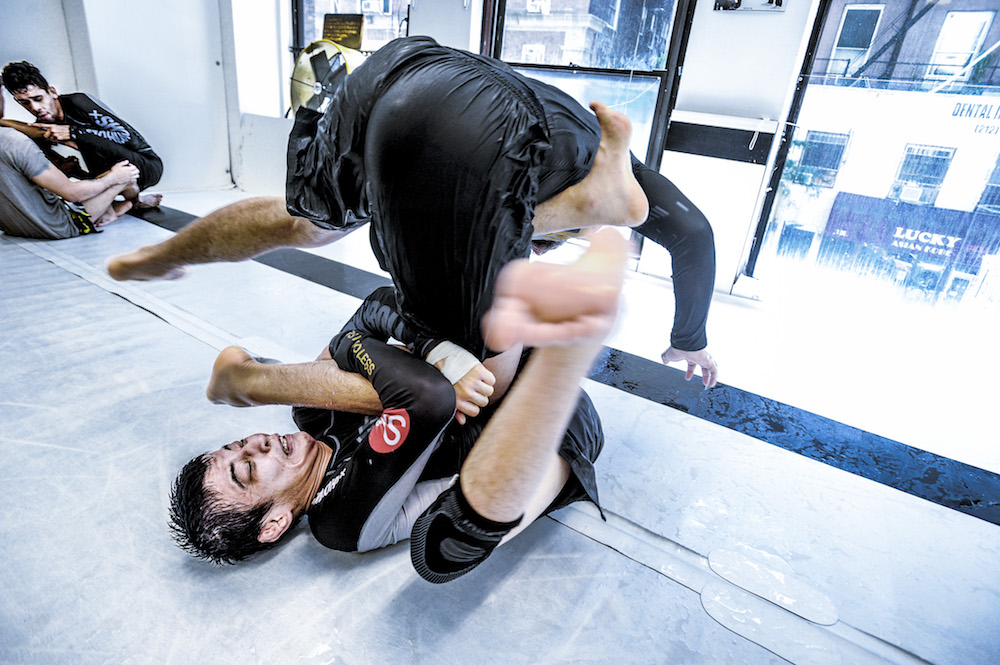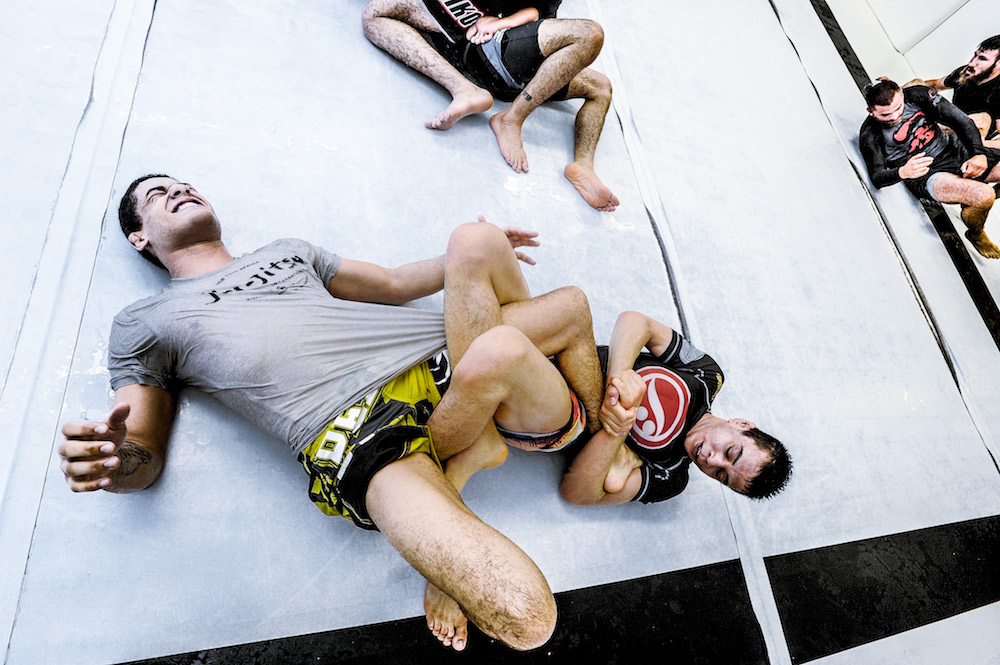Identical But Different: How Being Twins Made The Miyao Bros Exceptional
Identical But Different: How Being Twins Made The Miyao Bros Exceptional
What makes Paulo and Joao Miyao so fascinating is the level of success they've achieved within the sport of jiu-jitsu, their unique lifestyle choices, and -

What makes Paulo and Joao Miyao so fascinating is the level of success they've achieved within the sport of jiu-jitsu, their unique lifestyle choices, and -- above all -- their twinship.
This is the final part of our in-depth look into the lives of the Miyao brothers. Catch up on Part One and Part Two if you missed them.
The Miyao brothers are identical (or monozygotic) twins, which means their DNA is almost exactly the same. Only one-third of all twins in the world are identical; the rest are fraternal.
Born from a Japanese father and a Brazilian mother, they were raised to be individuals rather than a unit.
They weren't dressed in the same clothing, they didn't have the exact same social group, and they developed their own unique personalities. But they chose the same lifestyle and harbored the same passion for jiu-jitsu.
The qualities that saw them become the best jiu-jitsu competitors in the IBJJF ranking during the 2015-2016 season are both learned and inherent. But how does their twinship play into their success?
Jiu-jitsu isn't a martial art or sport that can be learned solo, so having an identical twin that shares the same passion is extremely beneficial. Paulo and Joao both discovered jiu-jitsu in their teenage years, and latched onto the lifestyle.
Since then, they've stayed on the path together.

Paulo (left) and Joao Miyao cool down during no-gi training in New York. Photo: Ric Ricard
Every person has an individual epigenome that determines how their DNA blueprint will be used. So even in the case of the Miyaos, their epigenetic factors began to cause differences between them right at birth.
Most people cannot tell the Miyao brothers apart, and rely purely on Paulo's missing front tooth to identify them. If you're around them long enough (or even just compete against them enough times), you'll be able to recognize that Paulo has a longer face than Joao, and Joao's nose is a bit less wide than Paulo's.
As they age, their epigenetic markers will actually drift and -- due to environmental factors that are still being studied -- their genetic make-up will differ more and more.
A combination of factors caused Paulo and Joao to choose BJJ as a career. Behavioral geneticist David Lykken described the heritability of interests as determined by a "cafeteria of experience." Someone who has certain precursor traits, like their physical and psychological characteristics and talent, will help determine what life experiences are selected and how that person reacts to the experience.
The Miyaos' intellect and craving for competition and adrenaline drove them to choose a life that provides them with never-ending possibilities for technical developments and challenges on the mat and in competition.
______
They are two people, and Paulo and Joao are definitely different people -- as can be seen in their jiu-jitsu careers.
Joao shows an affinity for no-gi, having fought in the 2013 ADCC World Submission Championships. He also conquered two IBJJF World No-Gi Championship titles. But Paulo has not competed in as many no-gi tournaments.
Even their promotions happened at different times. Paulo was promoted to brown belt a couple of months earlier than Joao, who received the rank in November 2012. It was essential to their growth that their professor, Cicero Costha, assessed their progress and rank individually by paying attention to their different timelines.
Their games differ as well.
Paulo plays a forward game that relies on stubbornness. If a pass or sweep attempt is met with resistance, Paulo continues until he succeeds by forcing his will on his opponents. Joao is more likely to adapt and try multiple sweeps or passes until he succeeds.
Now, more than ever, the brothers are adapting to a heavier top game. Over the years, their reputation was synonymous with playing guard and the use of the berimbolo. Now, they both allow their opponents to pull guard (or even try and use their judo background) to take top position. Joao still plays the berimbolo game more, but Paulo has been more inclined to sweep and pass.
Being twins does not ensure they will forever play the same game, but being constant training partners for one another (as well as training with the same team and people) will heavily influence their techniques and strategies.


Top: Joao Miyao attacks the lower body of his training partner during summer no-gi training.
Bottom: Paulo Miyao locks in a heelhook.
Both photos shot at Unity Jiu-Jitsu in New York. Photos: Ric Ricard
Kinetically Connected
As with many twins, there's an unspoken bond between the Miyao brothers.
It's commonly thought that twins develop their own language. As they develop their linguistic skills in the early years, they create their own way of communicating.
Beyond language, the brothers do connect in ways most siblings do not.
For example, at the 2016 World Championship, Joao was on the mat and Paulo was inside the barrier waiting for his next match.
Because it is against the IBJJF rules to coach a competitor from within the barrier, anything Paulo wanted to say to Joao was said by walking over to their coach Murilo Santana, who would then relay the information.
As Joao was fighting, I noticed Paulo was moving his body and contorting it as if he was also in the match. He didn't have anything to say and there was no eye contact between the two, yet he was making suggestive moves that could only be described as them being connected through some other sense.
______
It takes a certain type of person who can be competitive, goal-oriented, and consistent. These traits, too, have been determined to come from one's DNA -- not just how someone is raised.
'Eudaimonia' is a term first used by Aristotle to describe the goal that all humans should strive for: contentment and purpose in life.
This would sit well with what I know to be true about the Miyao brothers' goals in life.
They won't tell you that they want to win a certain number of titles, or that they'll retire once they've achieved a benchmark within their careers. They simply want to continue to be the best until their bodies won't let them anymore. They want to become the best people they can be and continuously search for satisfaction.
In many ways, they embrace the 'virtuous activity of soul' that Aristotle supported.
Psychologist Carol Ryff describes these traits as eudaimonic well-being. Their self-control, known as autonomy, is astounding as it is necessary to remain focused on their goals and their training.
No doubt, training and drilling day in and day out is not for the weak, and what dictates whether one will reach the gold or not is their self-determination. Environmental mastery is a facet that Paulo and Joao have been able to seek out as they first moved to Sao Paulo (and then later to Unity in NYC) for better training when they chose BJJ as their career.
______
Dr. Itzhak Lander notes that identical twins act as the primary caregiver for each other when adjusting to new situations. This would explain the reliance that Paulo and Joao can place on each other in order to comfortably seek out the best opportunities for their jiu-jitsu careers.
Having each other works well in other areas, namely on the mats.
The fact that the Miyaos have jiu-jitsu as their passion is incredible. They are able to compete against one another every day in training but also support one another in competition. This is seen as 'support rivals', in which there is a whole-hearted, mutual support for one another that drives them to be their best.
The existence of Paulo doing well will give Joao confidence considering their similar traits and abilities -- and vice versa. When they understand their limitations, they can push one another past these to be their best.
In this way, the Miyaos are a team within their team of training partners and mentors, and it allows for them to compete together against the outside world -- or in this case, their opponents.

Paulo (lying) and Joao (seated) Miyao rest after no-gi training at Unity Jiu-Jitsu gym in New York. Photo: Ric Ricard
We joke that they live on the mat and that they're always the guys who are willing to go one more round, but it is something to be admired, and something to aspire to.
Mentally and physically the Miyaos throw themselves at something to see how far they can go, together and alone. Through a combination of their genetics and their upbringing they're already set for a level of greatness, but having each other pushes them further and further.
• The Miyao Brothers vs. The World: Beating the Berimbolo
• Quit Or Get Tough: Training At Cicero Costha's Gym In Sao Paulo
• Paulo Miyao Just Loves Jiu Jitsu
• Miyaos Bros Drilling At Unity Gym In New York
This is the final part of our in-depth look into the lives of the Miyao brothers. Catch up on Part One and Part Two if you missed them.
The Miyao brothers are identical (or monozygotic) twins, which means their DNA is almost exactly the same. Only one-third of all twins in the world are identical; the rest are fraternal.
Born from a Japanese father and a Brazilian mother, they were raised to be individuals rather than a unit.
They weren't dressed in the same clothing, they didn't have the exact same social group, and they developed their own unique personalities. But they chose the same lifestyle and harbored the same passion for jiu-jitsu.
The qualities that saw them become the best jiu-jitsu competitors in the IBJJF ranking during the 2015-2016 season are both learned and inherent. But how does their twinship play into their success?
Jiu-jitsu isn't a martial art or sport that can be learned solo, so having an identical twin that shares the same passion is extremely beneficial. Paulo and Joao both discovered jiu-jitsu in their teenage years, and latched onto the lifestyle.
Since then, they've stayed on the path together.

Identical, But Different
Having almost the exact-same DNA makes them nearly identical. But just because their genetic code is the same, doesn't mean they haven't developed differently.Every person has an individual epigenome that determines how their DNA blueprint will be used. So even in the case of the Miyaos, their epigenetic factors began to cause differences between them right at birth.
Most people cannot tell the Miyao brothers apart, and rely purely on Paulo's missing front tooth to identify them. If you're around them long enough (or even just compete against them enough times), you'll be able to recognize that Paulo has a longer face than Joao, and Joao's nose is a bit less wide than Paulo's.
As they age, their epigenetic markers will actually drift and -- due to environmental factors that are still being studied -- their genetic make-up will differ more and more.
A combination of factors caused Paulo and Joao to choose BJJ as a career. Behavioral geneticist David Lykken described the heritability of interests as determined by a "cafeteria of experience." Someone who has certain precursor traits, like their physical and psychological characteristics and talent, will help determine what life experiences are selected and how that person reacts to the experience.
The Miyaos' intellect and craving for competition and adrenaline drove them to choose a life that provides them with never-ending possibilities for technical developments and challenges on the mat and in competition.
Similar, But Different Approaches To The Game
Over time, their paths have differed. In order for identical twins to develop their own personalities and identities, parents are often encouraged to emphasize the fact that they have two sons or two daughters, and not to simply refer to the two as a unit.They are two people, and Paulo and Joao are definitely different people -- as can be seen in their jiu-jitsu careers.
Joao shows an affinity for no-gi, having fought in the 2013 ADCC World Submission Championships. He also conquered two IBJJF World No-Gi Championship titles. But Paulo has not competed in as many no-gi tournaments.
Even their promotions happened at different times. Paulo was promoted to brown belt a couple of months earlier than Joao, who received the rank in November 2012. It was essential to their growth that their professor, Cicero Costha, assessed their progress and rank individually by paying attention to their different timelines.
Their games differ as well.
Paulo plays a forward game that relies on stubbornness. If a pass or sweep attempt is met with resistance, Paulo continues until he succeeds by forcing his will on his opponents. Joao is more likely to adapt and try multiple sweeps or passes until he succeeds.
Now, more than ever, the brothers are adapting to a heavier top game. Over the years, their reputation was synonymous with playing guard and the use of the berimbolo. Now, they both allow their opponents to pull guard (or even try and use their judo background) to take top position. Joao still plays the berimbolo game more, but Paulo has been more inclined to sweep and pass.
Being twins does not ensure they will forever play the same game, but being constant training partners for one another (as well as training with the same team and people) will heavily influence their techniques and strategies.


Bottom: Paulo Miyao locks in a heelhook.
Both photos shot at Unity Jiu-Jitsu in New York. Photos: Ric Ricard
Kinetically Connected
As with many twins, there's an unspoken bond between the Miyao brothers. It's commonly thought that twins develop their own language. As they develop their linguistic skills in the early years, they create their own way of communicating.
Beyond language, the brothers do connect in ways most siblings do not.
For example, at the 2016 World Championship, Joao was on the mat and Paulo was inside the barrier waiting for his next match.
Because it is against the IBJJF rules to coach a competitor from within the barrier, anything Paulo wanted to say to Joao was said by walking over to their coach Murilo Santana, who would then relay the information.
As Joao was fighting, I noticed Paulo was moving his body and contorting it as if he was also in the match. He didn't have anything to say and there was no eye contact between the two, yet he was making suggestive moves that could only be described as them being connected through some other sense.
Paulo Miyao vs. Paulo Filho, IBJJF 2016 Worlds
Joao Miyao vs. Gabriel Wilcox, 2016 IBJJF Europeans
Personality Traits by DNA
After the Miyaos' initial wins on the world stage at blue belt, they revealed their talent and skill by winning the majority of the many tournaments they entered.It takes a certain type of person who can be competitive, goal-oriented, and consistent. These traits, too, have been determined to come from one's DNA -- not just how someone is raised.
'Eudaimonia' is a term first used by Aristotle to describe the goal that all humans should strive for: contentment and purpose in life.
This would sit well with what I know to be true about the Miyao brothers' goals in life.
They won't tell you that they want to win a certain number of titles, or that they'll retire once they've achieved a benchmark within their careers. They simply want to continue to be the best until their bodies won't let them anymore. They want to become the best people they can be and continuously search for satisfaction.
In many ways, they embrace the 'virtuous activity of soul' that Aristotle supported.
Psychologist Carol Ryff describes these traits as eudaimonic well-being. Their self-control, known as autonomy, is astounding as it is necessary to remain focused on their goals and their training.
No doubt, training and drilling day in and day out is not for the weak, and what dictates whether one will reach the gold or not is their self-determination. Environmental mastery is a facet that Paulo and Joao have been able to seek out as they first moved to Sao Paulo (and then later to Unity in NYC) for better training when they chose BJJ as their career.
The Strength of Being a Twin
The move from their small hometown in a rural neck of the woods is a not a sacrifice that every person would make. Having each other spared much of the anxiety they may have suffered by being separated from their family and having to rely on themselves to survive in Sao Paulo.Dr. Itzhak Lander notes that identical twins act as the primary caregiver for each other when adjusting to new situations. This would explain the reliance that Paulo and Joao can place on each other in order to comfortably seek out the best opportunities for their jiu-jitsu careers.
Having each other works well in other areas, namely on the mats.
The fact that the Miyaos have jiu-jitsu as their passion is incredible. They are able to compete against one another every day in training but also support one another in competition. This is seen as 'support rivals', in which there is a whole-hearted, mutual support for one another that drives them to be their best.
The existence of Paulo doing well will give Joao confidence considering their similar traits and abilities -- and vice versa. When they understand their limitations, they can push one another past these to be their best.
In this way, the Miyaos are a team within their team of training partners and mentors, and it allows for them to compete together against the outside world -- or in this case, their opponents.

Adapt, Overcome, Evolve
I believe Paulo and Joao Miyao are adept at making the uncomfortable, comfortable. Exceptional athletes are defined by their ability to adapt, overcome, and evolve.We joke that they live on the mat and that they're always the guys who are willing to go one more round, but it is something to be admired, and something to aspire to.
Mentally and physically the Miyaos throw themselves at something to see how far they can go, together and alone. Through a combination of their genetics and their upbringing they're already set for a level of greatness, but having each other pushes them further and further.
Related articles
• Watch Paulo and Joao Miyao In A Grueling CrossFit Workout• The Miyao Brothers vs. The World: Beating the Berimbolo
• Quit Or Get Tough: Training At Cicero Costha's Gym In Sao Paulo
• Paulo Miyao Just Loves Jiu Jitsu
• Miyaos Bros Drilling At Unity Gym In New York